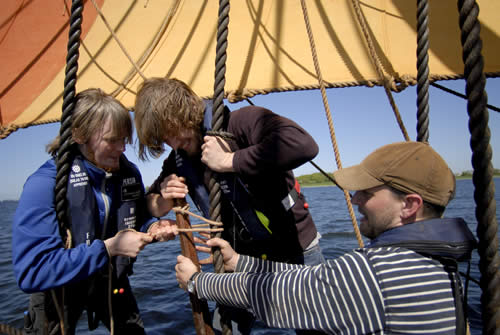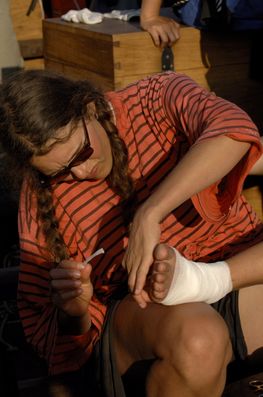Irish Culture Department to support Voyage

The Irish Minister for Arts, Sports and Tourism Mr. John O'Donoghue has announced financial support to the Sea Stallion experiment, making the historic Viking ship expedition this summer a truly Danish-Irish project.
On Sunday July 1st 2007 the World’s largest reconstruction of a Viking ship – a 30 metre long war ship replica - will leave the Viking Ship Museum harbour in Roskilde, Denmark and set its course for Dublin. Crewed by 65 international volunteers, the ship will ply the North Sea, the Atlantic Ocean and the Irish Sea. The arrival in Dublin is scheduled for Tuesday the 14th of August. During a six-week period the ship will be thoroughly tested in the waters the original ship was built to conquer.
The ship – The Sea Stallion of Glendalough – was built at the Viking Ship Museum between 2000 and 2004 being a precise reconstruction of a Viking ship originally built in Dublin in the year 1042. 30 years later the original ship was scuttled in Danish waters at the mouth of Roskilde Fjord as part of the city's defence.
“This is one of the largest marine archaeological experiments ever carried out. We are honoured and deeply grateful that Ireland welcomes the ship, the crew and the project in such a warm atmosphere. We understand that the Vikings were not always so welcome. This time the crew on board The Sea Stallion promise to behave.” says director of the Viking Ship Museum in Roskilde, Tinna Damgaard-Soerensen.
(Irish) Department of Arts, Sport and Tourism spokesperson Mr. Chris Flynn says: “This is the culmination of a project of many years gestation, and of cooperation between the National Museum of Ireland and the Roskilde Viking Ship Museum. The exhibition will be a fantastic use of the Collins Barracks exhibition space and I hope that everyone will take this unique opportunity of welcoming the Sea Stallion to Dublin Docklands on 14th August.”
Apart from being a historic event not carried out for a thousand years the scientific purpose of the expedition is to collect data for the scientists, historians and archaeologists. How did Vikings manage to navigate in such circumstances, what was the operational range for a war ship like this and what logistics was needed to build, crew and operate a war ship fleet are some of the questions raised prior to the expedition launch.
The Sea Stallion from Glendalough:
Length: 30,0 metre Width: 3,8 metre
Sail: 112 square metres
Weight (fully manned): 25 ton
Maximum speed: 15-20 knots
Crew: 65 (from 11 nations including 3 continents)
Distance from Roskilde to Dublin (via Orkney): Approximately 900 nautical miles. (1,666 kms)
More information on the ship:
Preben Rather Sørensen
Head of Secretariat
The Seastallion from Glendalough
Vindeboder 12
DK-4000 Roskilde
Tel: +45 46 300 208 / +45 2175 2070 Fax: +45 46 300 201
More information on the Viking Ship Museum: www.vikingeskibsmuseet.dk
More information on DAST:
Press & Information Office
Department of Arts, Sport and Tourism
Kildare Street, Dublin, 2
Ireland (Tel +353 1) 631 3806 / 3807 / 3838
Fax: (+353 1) 661 1201
Email: pressoffice(at)dast.gov.ie
More information on the Collins Barracks Exhibit. Aoife Demel , Marketing Department, National Museum of Ireland Tel. 00 353 1 6486429 . ademel(at)museum.ie
More information on the arrival event: Loretta Lambkin, Director of Marketing, Docklands Authority, Tel 00 353 1 818 3300 llambkin(at)dublindocklands.ie
Important Dates
28th June - Exhibition on the “ Havhingsten fra Glendalough” - Sea Stallion from Glendalough opens at National Museum of Ireland Collins Barracks
1st July - The Sea Stallion departs from Roskilde , Denmark.
14th/ 15th August - Welcoming ceremony for the Sea Stallion and two days celebration at Custom House Quay.
17th - 19th August – Sea Stallion arrives (17th) in National Museum of Ireland Collins Barracks with a weekend of Viking related activities
August – June 2008 – Sea Stallion and accompanying exhibition will be displayed at the National Museum of Ireland Collins Barracks.




